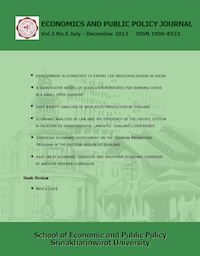DEVELOPMENT ALTERNATIVES TO EXPORT LED INDUSTRIALIZATION IN ASEAN
Main Article Content
บทคัดย่อ
The paper addresses micro (sectoral) and macro economic aspects of an alternative to “manufacturing exports-led” growth through regional trade agreements (RTAs) in ASEAN. While a return to the old protectionist, import substitution industrialization policies seems to have little support, agriculture remains, today, a large and typically lagging sector in the regional economies. The paper examines an alternative regional growth strategy: economic growth, in an open trade regime, driven by productivity growth in the agricultural sector. Comparative simulations are carried out in the empirically based GTAP computable general equilibrium (CGE) model to examine the implications of a strategy shift toward focus on agricultural productivity growth, in the region. The 57 sector Global Trade Analysis Project (GTAP) model is relatively detailed in its treatment of the agricultural sector making it suitable for this exercise. As the ASEAN Economic Community is to take effect in 2015 it is timely to examine the public policy options that will govern its development. We do so retrospectively, looking forward from 2001 to what has been more than a decade of preferential trade liberalization agreements as the engine of growth versus an alternative agricultural productivity focus.
The results of the simulations indicate real GDP gains to ASEAN members from a posited 1% Hicks neutral technical progress in 14 primary sector industries or 21 including agricultural processing industries that are, respectively, 5 to 10 times those from a discriminatory elimination of all tariffs on trade among ASEAN members, alone – larger than those from simulations of any of four other RTAs to include the members of ASEAN in a process similar to the ASEAN++FTA initiative announced in 2011. The technical progress leads to smaller sectoral expansions and contractions in output and trade along with the larger gains in real GDP in comparison to the RTAs. This implies lower adjustment costs of resource reallocation as well as greater benefits from a public policy focus on promoting economic growth through productivity growth in agriculture and food processing rather than through RTAs. In addition poorer members of ASEAN fare better in comparison to richer members from the technical progress in primary production and processing in contrast to the discriminatory trade liberalization of RTAs.
Article Details
สงวนลิขสิทธิ์ © 2553 คณะเศรษฐศาสตร์ มหาวิทยาลัยศรีนครินทรวิโรฒ
คณะเศรษฐศาสตร์ มหาวิทยาลัยศรีนครินทรวิโรฒ จัดพิมพ์วารสารเศรษฐศาสตร์และนโยบายสาธารณะ เพื่อเผยแพร่บทความวิชาการทางเศรษฐศาสตร์ นโยบายสารธารณะ และสาขาอื่นๆที่เกี่ยวข้อง ทัศนะและข้อคิดเห็นใดๆ ที่ปรากฏในวารสารเป็นความคิดเห็นส่วนตัวของผู้เขียน โดยบทความที่ได้รับการตอบรับจะถือเป็นลิขสิทธิ์ของคณะเศรษฐศาสตร์ มหาวิทยาลัยศรีนครินทรวิโรฒ
บรรณาธิการ อาจารย์ ดร.พลพัธน์ โคตรจรัส


